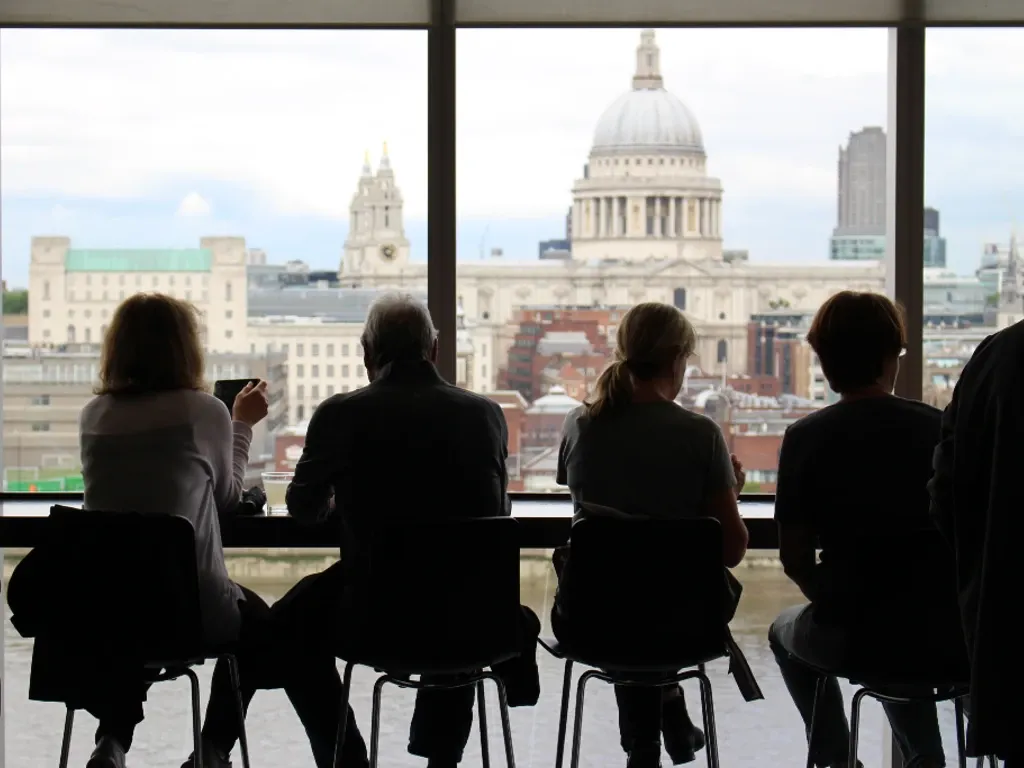
18 Things To Do in London
Table of Contents
“When a man is tired of London, he is tired of life; for there is in London all that life can afford." English writer Samuel Johnson said this back in 1777—but he could have said it today because, now more than ever, London is one of the most exciting cities in the world.
It’s where 2,000 years of history meets the future in the making. There are always a million things happening—thrilling, for sure, but also potentially overwhelming. Plan, but don’t pack in too much. A few words to the wise: The British Museum will occupy your whole morning, unless you pretty much plan to see the Rosetta Stone only and bolt; sunset is definitely the best time to get on the London Eye (if you can buy tickets in advance, do it); and amazingly, many of the best museums in London are free to enter.
Beyond the big names, there is still a whole world to explore. The art scene is world-class, the restaurants have never been more exciting, the traditions are quirky, and the opportunities for cultural exploration are endless. Regardless of what you choose to do in London, you’ll leave with stories to tell.

The Greenwich Meridian

Whereas the equator divides the north half of the Earth from the south, the prime meridian is a line that divides the east and the west—and that line is in East London, in Greenwich to be precise. The line is marked at the Greenwich Observatory, where you can take the customary photo with a foot in each hemisphere. To learn about the race to find the meridian (and why it mattered so much), head into the Royal Observatory, which also has brilliant planetarium shows.
The observatory is open daily, and you should book tickets in advance if possible (entry is £18; planetarium shows cost extra). While you have to get tickets for the observatory to stand on the official meridian line, look out for the green laser beam that marks the meridian line in the evening, cutting through Greenwich Park.
Tate Modern

The Tate Modern is spectacular, and that’s before we even touch on the art. This gallery is located in an old power station on the South Bank, and the old turbine hall is still used to host large-scale artworks that would fit nowhere else—with no entry fee. Once inside, you’ll find a world-class art museum displaying works created from the early 1900s–present day; it also happens to host some of the best art exhibitions, not just in London, but around the world.
There are two Tate galleries. Tate Modern, which is on the South Bank, has British and global contemporary art (highlights include Picasso, Mondrian, Warhol, Magritte, Rothko’s Seagram murals, and Yayoi Kusama’s Infinity Mirror Rooms, whose stay has been extended until April 2024). There’s also Tate Britain in Pimlico, which is home to British art from 1500–present day. At both sites, the general collections are free, but the special shows are ticketed, so you should plan ahead. Hot tip: The Tate galleries have some of the best gift shops in the city, selling prints, books, and arts- and London-themed souvenirs bound to please even the most discerning recipient.
A Sunday roast

The main event of a traditional British roast dinner is beef, but ask a Brit and they may well tell you it’s all about the roasties—that’s roast potatoes, which are soft on the inside and crispy on the outside. These days, roasts can just as easily be chicken, pork, or vegetarian, but the sides are still likely to be focused on carrots, parsnips, gravy, and, of course, Yorkshire puddings (a baked, savory popover with a cake-like consistency). Save your appetite, as you’re going to need it.
The traditional Sunday roast hour is 3pm, but as people increasingly time their roasts for dinnertime, double check your invite. Roasts are served all over London on Sundays, so if you scout out a nice pub, you should go ahead and make a reservation. Hawksmoor, which has a few restaurants across the city, has a top-notch roast. For the traditional experience of a pub roast—along with a full choice of ales, bitters, and lagers—you can’t go wrong with the cozy and historic Holly Bush in Hampstead.
Buckingham Palace

Buckingham Palace sits at the intersection of three great London parks: Hyde, St James’s, and Green parks. This is the official residence of King Charles III, and believe it or not, it’s still possible to go inside the residence on select dates, including ten weeks in the summer. Even if it’s closed for visitors, it’s worth swinging by—the massive fountain featuring Queen Victoria in the courtyard is a great place to have a rest.
To enter Buckingham Palace, you should book ahead (standard entry is £30, with options for guided tours at extra charge). The Royal Mews, which are the stables and where the ornate royal carriages are kept, are open March–October (£15 entry). The Queen’s Gallery at Buckingham Palace, which has artworks and furniture from the Royal Collection, is open year round. These buildings are part of the working royal palace, so confirm there are no last-minute closures before visiting.
The River Thames by boat

Thanks to building density and relatively few hills, London is unfortunately lacking in good viewpoints, but seeing the city from the River Thames is a great opportunity to get some perspective. There are lots of guided tours available, but a surprisingly good option for a river cruise is the Thames Clipper (currently branded as Uber Boat). It’s technically a commuter service, stopping at 24 piers along the river, but the vessel has outside and inside seating, and it takes you past Big Ben, St. Paul’s Cathedral, and under Tower Bridge. It’s especially nice to get the Thames Clipper from central London to Greenwich, making the longer journey a scenic feature. You can also use it to hop between the two Tate galleries, as both are close to river piers.
Prices for the Thames Clipper start at £5.20, and you can pay with your Transport for London travel card.
The Design Museum

London’s Design Museum is dedicated to the development of design through the ages. Located in a new, striking building in Kensington on the edge of Holland Park, this is an innovative space with world-class exhibitions. Past shows include Charlotte Perriand, Paul Smith, and Azzedine Alaïa, as well as themed displays on phenomena such as ASMR, design in football, surrealism, and California. The museum will host an Ai Weiwei show until August 2023, and starting in fall 2023, there are exhibitions on the history of skateboarding and an exploration into how London fashion repeatedly sets the creative agenda.
The Design Museum’s general collection is free to visit, with extra charges for special exhibitions.
Afternoon cream tea

Crustless sandwiches, scones with clotted cream and jam, little cakes, endless tea, and flutes of champagne if you’re fancy—cream tea is served. The proper time to indulge is 3-4pm, but you can book it for lunchtime and call it good, as there will be plenty of food. You can sometimes get gluten-free and vegan cream teas, too, but you’ll want to check ahead. To ensure you get your first choice, bookings are recommended at least a month in advance.
There are lots of opportunities to get a proper cream tea in London, but some favorites include:
- The Ritz: Where teas are selected by the certified Tea Master (from £70)
- The Dorchester: Enjoy historic recipes steeped in tradition (from £110)
- The Langham: In the elegant surroundings of the Palm Court (from £75)
- Sketch: Indulge yourself in London’s pinkest restaurant (from £80)
- Fortnum & Mason: Served in the Diamond Jubilee Tea Salon (from £78)
Camden Market

Camden Market is legendary. This is the place for cool vintage, independent fashion, handmade jewelry, and things you didn’t even know would tickle your fancy until they do. A visit to Camden Market can easily be a full day—with 206 stalls the place is huge, and there are plenty of food options too. But there’s a lot to do in addition to shopping: Camden itself is a thriving London neighborhood with pubs, restaurants, and a cool music scene.
Camden Market stretches north from Camden Town Tube station. It’s free to visit unless, of course, you plan on making any purchases. The main market is open every day until late (times vary, so be sure to check the schedule); opening hours also may vary for smaller markets and individual retailers.
The London cable car

The London cable car is an official part of Transport for London, but it’s increasingly also used as a fun thing to do (and unofficially as a place to film TikTok videos). The cable in question is suspended in the air; it’s basically a gondola. The trip across the Thames takes about eight minutes and gives you an unparalleled view of the Thames and the Docklands. While in the area, consider taking a walk over the O2 Millennium Dome in Greenwich—yes, that’s an open-air traverse across the outer dome. You can get tickets online (from £35, with options for twilight or sunset walks).
The London cable car, officially named the IFS Cloud Cable Car, runs between North Greenwich and Royal Victoria Dock stations in East London. Depending on the day, it operates starting around 7-9am until 10-11pm, which is not as late as the Tube; you’ll want to confirm the cable car schedule ahead of time. You can pay using your travel card or book online (from £6). Also, check to see if there are special slowed-down crossings available for a more leisurely journey—these sometimes even come with a meal service (at additional cost).
See Tower Bridge as it opens

It’s considered good luck to witness the opening of Tower Bridge because it doesn’t happen that often. It’s true: It’s easy to miss, but it does happen almost every day, and you can catch it if you know where to look. (Spoiler: It’s posted on the website.) This is because boats need to request that the bridge be opened in advance, so check the schedule and get to your viewing spot in time. You get the best view if you walk up onto the bridge and watch as the mid-section (between the central towers) rises in front of you. Don’t worry, they close the road before this happens.
(Tower Bridge is often mistaken for London Bridge. Tower Bridge is the fancy one with two levels. London Bridge is the next one over, and it’s very plain.)
It’s free to see Tower Bridge lift. Afterward, consider going into Tower Bridge itself. The entrance is in the north tower, which lets you walk across the top section and also grants you access to the engine room down below. You can get tickets online for £12.30.
Hackney Wick

Hackney Wick is a neighborhood in East London famous for its thriving and edgy arts scene. Over the past 20 years, people have moved here from all over the city in search of cheap studio space. While the area has gentrified a fair bit since then, much of its eclectic energy remains, and there are more bars and restaurants than ever to make this a great place to spend a leisurely afternoon of exploration.
Here are some local favorites in Hackney Wick:
- Thingy Café: Located in a hidden garden
- Crate Brewery and Pizza: With outside seating in the Wick’s liveliest yard
- Grow: Nothing beats it for a slow afternoon by the water
- The Lord Napier: A formerly derelict but now excellently refurbished pub
- Two More Years: On Fish Island, for a drink by the canal
To get to Hackney Wick, take the Overground to Hackney Wick station. Explore the area around the station and toward the water, then wander down to cross the canal bridge to Fish Island; the Old Ford Lock marks the area’s southern perimeter.
The V&A

The Victoria and Albert Museum in Kensington is a never-ending adventure—at least it feels that way as you walk through the maze of artifacts covering 5,000 years of human history. It’s almost as if the museum contains the whole world, but the through line is design, decorative, and applied arts—that’s textiles, ceramics, jewelry, printmaking, furniture, photography, glass, sculpture, and more. If someone’s made it, you’ll find a version of it in the V&A.
General admission to the V&A collection is free, with extra charges for special exhibitions. The main V&A museum is in Kensington; travel to East London for Young V&A, formerly known as the Museum of Childhood, which reopens after a long refurbishment in July 2023.
Sir John Soane’s Museum
Distinguished architect Sir John Soane left his home to the public after his death, and this central London terraced house is now a brilliant and unusual museum. It’s filled with artwork, sculptures, furniture, and curiosities, and the domestic setting really makes this space what it is. Soane even added clever methods to get more daylight into his house in anticipation of its future role, as well as paintings that reside in cupboards to save space—it’s a feast for the senses.
Check if your visit coincides with Soane Lates, a monthly late-night opening of the museum where you can wander around with everything lit by candles. Soane Lates are £25, but standard entry is free.
The rose garden in Regent’s Park

Queen Mary’s Garden in Regent’s Park is famous, and rightly so: There are roses for days here, of every possible color, growing larger than you’d think possible, and smelling to high heaven. The rest of Regent’s Park is great too, with expertly cared-for lawns and trees and opportunities to rent rowboats. Families might want to visit the London Zoo (from £30), which is located at the northern edge of the park. The Regent’s Park Open Air Theatre is one of the biggest in London, putting on quality productions. Summer 2023 shows include a reimagination of Shakespeare’s Tempest, the famous La Cage aux Folles musical, and several modern productions.
Entry to Regent’s Park is free, but there are opening hours, so you’ll want to plan ahead. The peak of the rose bloom is in the first two weeks of June.
Going Picks for best things to do in London
You cannot go wrong with the top-notch London attractions listed above. But if you really want to get a feel for the city the way locals experience it, here are Going’s insider picks for cool, under-the-radar things to do.
Hidden London tours by Transport for London

London’s transport authority, Transport for London, has a brilliant museum in the center of the city, where adults and kids alike can roam the carriages and explore incredible graphic design (£24 for a ticket that’s good for a year; book online). But the insider tip is to book one of Transport for London’s Hidden London tours, where you can venture into abandoned Tube stations and see original vintage designs in situ, as well as the warren of tunnels where Winston Churchill sheltered during the WWII Blitz.
Hidden London tours run on select dates; be sure to book ahead to lock in your desired time.
The Barbican Conservatory

The Barbican Conservatory is a secluded indoor tropical garden right in the middle of London. Sure, the greenhouse at Kew Gardens is bigger, but this one feels like discovering a secret—who would have thought this brutalist structure would contain an urban oasis?
The Barbican Conservatory is free; snag one of the limited tickets one week in advance on the website. If you’re into architecture, the Barbican as a whole is well worth a visit. The place is huge, intriguing outside as well as inside, and unlike anything or anywhere else. The Barbican Centre also has an excellent art gallery, cinema, theater, and dance performances (most at extra charge). Check the website to see what’s on.
The Hampstead ponds

Hidden away on London’s glorious Hampstead Heath are three open-air swimming ponds. The Mixed pond—which admits everyone—is open in the summer and shoulder seasons only, but the Men’s and the Ladies’ ponds are open every day, drawing in Londoners to swim year round. These are ponds, not pools—the water is deep and silty, so it’s for competent swimmers only. Even in summer, it never really gets above 71°F. There are showers, but changing facilities are rudimentary, and there are no lockers. But make no mistake: To take a dip in a Hampstead pond is to take part in something beautiful.
The Hampstead ponds are run by the City of London. Children under eight are not allowed, and kids 8–15 must be accompanied by an adult and pass a swim test. Opening hours vary so check ahead, and in summer, pre-booking is required. Pay online (£4.50) or with a contactless card at the gate.
See St. Paul’s Cathedral from Richmond Park

Sure, you can visit St. Paul’s Cathedral in the city—it’s an architectural masterpiece whose dome is one of the largest in the world. The Whispering Gallery, in particular, is recommended once it reopens, though it is “closed until further notice” (entry will be £20.50 when booked ahead). But for a different perspective, head to Richmond Park in West London. There, point your feet toward King Henry’s Mound, where a conveniently located telescope will help you locate St. Paul’s Cathedral, 12 miles away as the crow flies. This is a protected view, so the trees will be pruned to make sure you can always access it.
Richmond Park has plenty of other things to do as well. The 2,500-acre park is a protected habitat for wildlife and home to a surprisingly large herd of deer, which you may well run into as they’re not scared. Isabella Plantation is also worth a visit, where highlights include the evergreen azaleas and, in the spring, endless fields of bluebells.
Richmond Park is free but has opening hours, so plan ahead.
How to get around London
The city is big, so don’t underestimate travel times. Londoners favor the free Citymapper app to show them the best routes. Locals use their debit or credit cards to tap into public transport; a day cap is automatically implemented when the level (£11.70) is reached. Many foreign bank cards can be used in the same way, but you may incur foreign transaction fees. Visitors can also buy an Oyster, a pre-loaded travel card that works in a similar fashion, or a paper travel card for a day, week, or month (these are available at most Tube or train stations). These payment options cover all transportation in and around London, including the Tube, the bus, suburban rail, the Docklands Light Railway, and the Overground.
See Going's deals on flights to London, and join today to get cheap flights from all over the world delivered right to your inbox.
Other London Guides
Published November 29, 2023
Last updated January 9, 2024
Articles you might like
View AllTreat your travel to cheap flights
Most deals are 40-90% off normal prices with great itineraries from the best airlines. If it's not an amazing deal, we won't send it. Sign up for free to start getting flight alerts.




